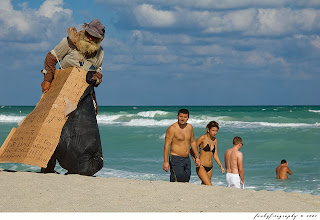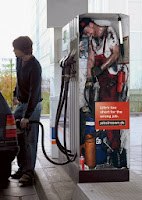How often do you hear someone say, “It’s all a matter of
perspective!” (Usually when their perspective on an issue differs from yours).
 A camera is a powerful instrument for making a point
about your own perspective. Often when a
photographer takes a very different point of view, it dramatizes the subject,
whether the subject is nature, a wedding, a portrait or a social issue. Some students in this course have presented
images from very unusual points of view and their images “pop” accordingly.
A camera is a powerful instrument for making a point
about your own perspective. Often when a
photographer takes a very different point of view, it dramatizes the subject,
whether the subject is nature, a wedding, a portrait or a social issue. Some students in this course have presented
images from very unusual points of view and their images “pop” accordingly.
Liz Moore shared with me these two images of the same cars
taken from different perspectives. Above they look like real cars on a real street; on the right it is revealed that they are tiny models. They certainly
make the point about perspective nicely. (More of the same here.)
 |
| What is the message intended by this image? |
Using a similar technique, compelling social commentary can
be made without uttering a syllable. This collection of images on flickr addresses the notion that you can
make effective social commentary simply by creating an image that brings
together the elements of your insight and put them in the perspective you wish
to portray. It’s extraordinarily
powerful.
 Surely that power should bring with it a responsibility
– so another big question is the degree to which both mainstream and social
media use this awesome power to act in a socially responsible fashion. Many people objected to Rolling Stone Magazine portraying the Boston Marathon bomber like a rock star – of course the editors insist
it is simply journalism. What do you think? What perspective could the editors have had?
Surely that power should bring with it a responsibility
– so another big question is the degree to which both mainstream and social
media use this awesome power to act in a socially responsible fashion. Many people objected to Rolling Stone Magazine portraying the Boston Marathon bomber like a rock star – of course the editors insist
it is simply journalism. What do you think? What perspective could the editors have had? |
| click to see larger image |
 |
| click to see larger image |
On the other hand, the German government has combined the
great use of clean, simple images on the sides of vending machines with a
wonderful sense of humour to make the point that education is the gateway to
better-paying and more satisfying jobs. No
one could find fault with that social message. In some countries it is hard to imagine a government with a sense of humour.
Perspectives on Beauty
One of the most obvious false perspectives is one that greets our eyes everywhere. Beautiful women are a delight to behold, so we rarely complain when we see them. The problem, of course is that the image of beauty created in those images is non-existent in nature, and it sets a standard impossible for any woman to meet. Take a look at how the most ordinary-looking young woman is transformed into a
fictional image of beauty. This unrealistic portrayal of beauty cannot help but suggest to all women that they
are falling short.
 |
| Same girl after Photoshop |
 |
| Ordinary girl before Photoshop |
It is hard to believe it is the same woman in both pictures, but you can see how the transformation is made in the short youtube video. Yet again, we see how photography is used to create an unusual perspective -- this time striving to create a fantasy perspective on female beauty that stirs the kind of anxiety that will sell cosmetic products (other than Photoshop).
A Beautiful Perspective
 |
| click for full size |
 |
| click for full size |
And for your visual pleasure here is a page with many more delicate and beautiful snowflake pics as well as an explanation of how you can make your own.

















